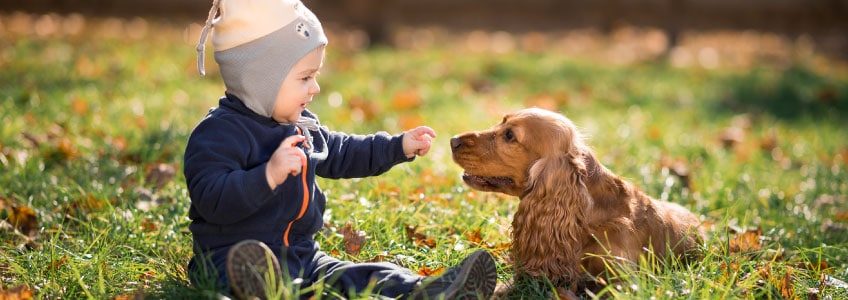
Raising children around pets, especially dogs, is proven to have a number of different benefits. Children who grow up with dogs demonstrate more empathy, develop fewer allergies and respiratory ailments, and often have higher self-esteem and motivation. When toddlers and dogs are sharing a home, though, it’s important to be prepared to do a little extra work to keep everyone safe, happy, and sane. Toddlers tend to be louder and more physical as they become more mobile and curious about the world around them. These normal developmental behaviors can be confusing, annoying, or even threatening to dogs. The trainers at Augusta Dog Training have some helpful advice for a peaceful, happy, and beneficial coexistence for your human and canine pups.
1. Practice Handling
One of the major pain points for dog-toddler homes is how toddlers handle dogs. Practice with both your child and your pet to make their interactions safer. Before you begin allowing your toddler to pet your dog, get your dog used to being handled in ways that mimic the unpredictable and less coordinated movements of your toddler. Speaking gently and offering plenty of treats, touch your dog’s ears, gently tug their tail, and rub their fur. If your dog shows any signs of irritation or aggression when touched in any of these ways, take note and make sure to be extra vigilant when they’re interacting with your toddler. Likewise, you’ll need to teach your toddler how to properly handle your dog. Using the methods of positive reinforcement, demonstrate how to properly handle your dog using simple language, such as “gentle” and “soft.” Reward your toddler when they do it correctly. If your child gets too rough, gently take their hand away, calmly say “no” and explain that touch could hurt the dog. If the behavior continues, redirect the child to something else away from your pup. Be diligent and gentle. Due to their ongoing development, toddlers may take some time to get the hang of it.
2. Create Boundaries
Setting up physical and behavioral boundaries will help in maintaining everyone’s happiness. Use baby gates to block off areas where your dog and child can play or nap separately without worrying that one will disturb the other. Make sure your dog has a place to get away when they need space or seem agitated. When your dog feels safe and knows they have somewhere to retreat, they’ll stay calmer and more content. If your toddler is having an outburst, as toddlers are wont to do, make sure to keep them away from the dog until they’ve calmed down. Having a dog is a great way to teach your child social boundaries. Like with proper touching, teach your child to leave your dog’s toys, food bowls, and beds alone. Reward your child when they demonstrate good social skills with your dog. In essence, you’re training them too.
3. Never Leave Your Toddler and Dog Unattended
Even the sweetest pups can lash out when they’re agitated or being touched in a way that they don’t like. It’s vitally important that dogs, no matter how well-behaved, are never left alone with young children. Left unattended, toddlers may inadvertently hurt, frighten, or annoy a dog, putting them in danger of injury. Keeping a close watch on your dog and toddler allows you to monitor both their behavior and body language, giving you the opportunity to teach and guide them. If your dog shows signs of aggression toward your child, it’s important to seek the advice of a professional trainer, animal behavior specialist, or vet.
4. Create Supervised Involvement
Teaching your toddler that they’re part of the team that takes care of the dog can help improve their general behavior with animals and help your dog learn to trust them. Let your child help out with feeding by allowing them to put a scoop of food in their bowl. Teach them to say “okay” when it’s time to let your dog eat. Create a special meal time activity for you and your toddler to do together to teach them to leave the dog alone while they eat. Set up a bedtime routine for giving special gentle pets to your pup. If your dog’s temperament allows, older toddlers can give a special treat to the dog once a day to establish bonding.
5. Let Yourself Ask For Help
Struggling to socialize a dog and toddler is not a sign that you or they are bad. We’re writing this blog because we know how challenging it can be to manage the often unpredictable behaviors of dogs and little ones. If you notice signs of agitation, stress, or aggression in your dog, it’s a sign that you should seek the help of a trainer. Look for unusual licking, panting, yawning, or stalking behaviors. Keep an ear out for growls and snarls. If a housebroken dog begins to go in the house, it could be a sign that they’re struggling with the current situation. Don’t despair. There are professionals out there who are prepared to help with precisely these situations.
Train Your Dog With Augusta Dog Training
Augusta Dog Training has offered customized in-home dog training to the Twin Cities for more than two decades. If you need extra help getting your dog and toddler to engage well together, reach out for a consultation. We’ll come to your home, assess your needs, and craft a custom training regimen to help you acclimate your dog and toddler to one another. If you or your dog need a break, we also offer boarding and daycare services. Call one of our offices to set up an initial consultation and evaluation, or visit us online.


